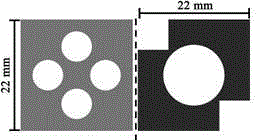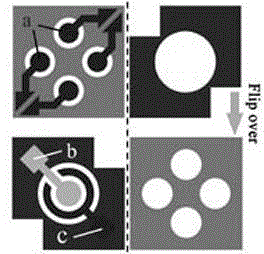Preparation for molecularly-imprinted electroluminescent paper chip for detecting multiple sample pesticide residues
A molecular imprinting and luminescence technology, applied in the preparation of paper chips, electroluminescence sensor chips to detect pesticide residues in fruits and vegetables, can solve the problems of many steps in the detection process, unfavorable rapid detection, complex pretreatment, etc. , to achieve fast detection speed, high-throughput screening, and simple operation
- Summary
- Abstract
- Description
- Claims
- Application Information
AI Technical Summary
Problems solved by technology
Method used
Image
Examples
Embodiment example 1
[0046] Implementation Case 1 (Dimethoate detection)
[0047] A method for preparing a molecularly imprinted electroluminescent paper chip for detecting pesticide residues in multiple samples, comprising the following steps:
[0048] (1) Prepare folded paper chips: first print on A4 paper with a wax printer as attached figure 1 Put the wax pattern on the A4 paper with the wax pattern in a flat heater or an oven, and heat it at 60-150 ℃ for 0.5-2 min, so that the wax melts and soaks through the entire thickness of the paper to form a hydrophobic area; The method of screen-printing the electrode, printing the carbon working electrode on the non-printed hydrophilic area of the treated A4 paper (attached figure 2 a), counter electrode (Fig. 2 b) and Ag / AgCl reference electrode (Fig. figure 2 c);
[0049] (2) Select the functional monomer methacrylic acid (MAA) that can synthesize MIPs with dimethoate;
[0050] (3) Dimethoate, the template molecule of residual pesticides,...
Embodiment example 2
[0059] Implementation Case 2 (Detection of parathion)
[0060] A method for preparing a molecularly imprinted electroluminescent paper chip for detecting pesticide residues in multiple samples, comprising the following steps:
[0061] (1) Prepare folded paper chips: first print on A4 paper with a wax printer as attached figure 1 Put the wax pattern on the A4 paper with the wax pattern in a flat heater or an oven, and heat it at 60-150 ℃ for 0.5-2 min, so that the wax melts and soaks through the entire thickness of the paper to form a hydrophobic area; The method of screen-printing the electrode, printing the carbon working electrode on the non-printed hydrophilic area of the treated A4 paper (attached figure 2 a), counter electrode (Fig. 2 b) and Ag / AgCl reference electrode (Fig. figure 2 c);
[0062] (2) Select the functional monomer o-nitrothiophenol that can synthesize MIPs with parathion;
[0063] (3) The template molecule parathion, the functional monomer o-nit...
PUM
 Login to View More
Login to View More Abstract
Description
Claims
Application Information
 Login to View More
Login to View More - R&D
- Intellectual Property
- Life Sciences
- Materials
- Tech Scout
- Unparalleled Data Quality
- Higher Quality Content
- 60% Fewer Hallucinations
Browse by: Latest US Patents, China's latest patents, Technical Efficacy Thesaurus, Application Domain, Technology Topic, Popular Technical Reports.
© 2025 PatSnap. All rights reserved.Legal|Privacy policy|Modern Slavery Act Transparency Statement|Sitemap|About US| Contact US: help@patsnap.com


